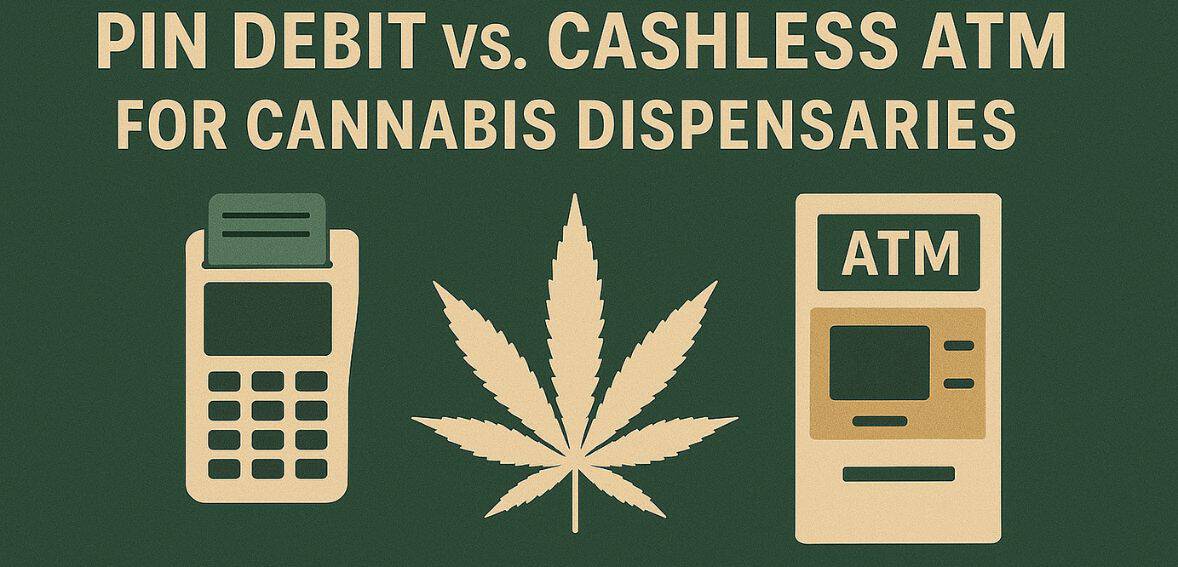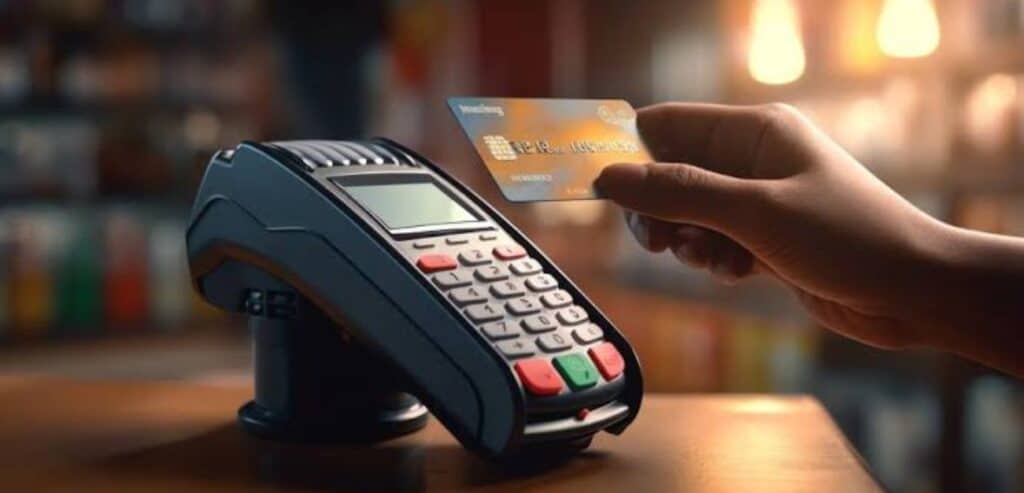
By alphacardprocess July 9, 2025
Financial transaction barriers have long existed in the cannabis industry. Even in states where cannabis-related businesses are completely legal, traditional banks are still hesitant to serve them because of federal regulations in the US. In a market that relies heavily on cash, this poses a special challenge: how to provide consumers with safe, practical, and legal payment options.
Two well-liked strategies have surfaced among the developing alternatives to meet this need: cashless ATMs and PIN debit. Dispensary operators who wish to improve customer satisfaction while upholding financial transparency and regulatory compliance must comprehend the key distinctions between these two options.
The Cash Problem in the Cannabis Industry

Cannabis is still categorized as a Schedule I controlled substance under federal law, even though there is a continuous movement to legalize it in several states. For many dispensaries, this classification complicates or even eliminates traditional banking relationships. Because of this, cannabis companies frequently function as cash-heavy businesses, which leads to operational inefficiencies, security issues, and accounting challenges.
Risks associated with a cash pile include internal theft, external robbery, and a lack of reinvestment opportunities. Additionally, it puts more strain on management and employees, who are responsible for managing the handling, transportation, and storage of cash. Dispensaries have resorted to alternative payment technologies in an attempt to get around these problems and update their business practices.
Two popular electronic payment methods that seek to mimic the ease of card-based payments found in other retail settings are PIN debit and cashless ATMs. Although they may appear to be similar from the customer’s point of view, they operate very differently and are viewed differently from a legal and regulatory perspective.
What is a Cashless ATM

A cashless ATM, sometimes referred to as a point-of-banking system, mimics the experience of withdrawing money from an ATM, but no physical cash is dispensed. Instead, the transaction is handled as a cash withdrawal from the client’s bank account. If the purchase amount is less than the withdrawal amount, the dispensary will give the customer change after they insert their debit card, choose an amount (usually rounded to the nearest increment, like $10 or $20), and enter their PIN. The customer’s bank statement shows the transaction as an ATM withdrawal.
The simplicity of cashless ATM systems and their apparent ability to circumvent federal regulations are what make them so appealing. Technically, dispensaries only assist with withdrawals; they do not handle “purchases.” Regulators and financial institutions have noticed this workaround, though, and it is becoming less and less clear if it will continue to be viable. Visa and Mastercard have both issued statements discouraging or outright banning the use of their networks for cannabis-related cashless ATM transactions. As compliance scrutiny increases, relying on cashless ATMs becomes riskier.
How PIN Debit Works
On the other hand, PIN debit transactions operate more like conventional retail purchases. The precise amount of the sale is deducted straight from the customer’s account after they insert their debit card and input their PIN. No change is given, no rounding occurs, and the nature of the transaction is not misrepresented. Customers and dispensary operators can benefit from increased transparency and a cleaner experience as a result.
In order to ensure that the payment network complies with all known regulatory requirements, PIN debit systems usually collaborate with sponsor banks that are prepared to conduct business in the gray area of cannabis commerce. PIN debit is frequently regarded as a more genuine and long-term solution than cashless ATMs, despite its challenges, such as locating a merchant service provider ready to facilitate cannabis-related transactions. Customers, banks, and regulators can all see the transactions more clearly because they appear to be retail purchases rather than ATM withdrawals.
Customer Experience and Convenience

Both methods are intended to provide convenience beyond a cash-only model from the perspective of the user. On the other hand, PIN debit usually offers a smoother experience. Customers frequently have to choose from predetermined withdrawal amounts and handle receiving change when using cashless ATMs, which can be uncomfortable and perplexing. The issue of additional costs associated with ATM-style transactions is another.
However, PIN debit eliminates the need for extra steps or needless rounding by enabling customers to pay the precise amount of their purchase. Other digital solutions, such as contactless payments, are also enhancing customer convenience across the cannabis retail space. Card acceptance is an additional consideration. When combined with the appropriate service providers, PIN debit systems typically have higher approval rates, even though many banks restrict or flag cannabis-related transactions. Network outages, declined cards, and blocked accounts are becoming more commonplace for cashless ATMs. This inconsistency creates friction at the point of sale and can hurt customer trust.
Compliance and Legal Risks
Compliance with state and federal regulations is one of the cannabis industry’s top priorities. Federal banking laws still have a significant impact, even though some states have implemented their regulations pertaining to cannabis payment methods. Payment processors and banks may become suspicious of cashless ATM transactions since they frequently misidentify the transaction as a bank withdrawal rather than a cannabis sale. Such misclassification may result in the closure of merchant accounts or even legal action as oversight becomes more stringent.
On the other hand, properly configured PIN debit solutions provide improved traceability and transparency. These systems offer comprehensive transaction records that correspond to the sale of cannabis products and make use of precise merchant category codes (MCCs). In addition to lowering regulatory risk, this improves the basis for upcoming financial audits, tax preparation, and reporting.
Operators of dispensaries must think about how sustainable their payment systems will be in the long run. A cashless ATM might be a quick fix for immediate problems, but it might endanger long-term business operations. Establishing a trustworthy financial infrastructure requires establishing connections with service providers who are aware of cannabis compliance.
Accounting, Auditing, and Transparency
PIN debit systems provide an unmatched level of clarity in accounting. Bookkeeping is made much simpler since each transaction represents the true sale price. More accuracy can be achieved in understanding revenue streams, matching receipts, and reconciling daily totals. When transaction histories match inventory sales and point-of-sale records exactly, financial audits also become less stressful.
Cashless ATMs can complicate the financial trail because of their workaround structure. The quantity of cannabis sold may not be directly correlated with each transaction since it is recorded as an ATM withdrawal. This may lead to disparities that tax authorities and auditors may scrutinize. As a result, there may be more scrutiny and a need to manually align financial records, which could result in inefficiencies and higher operational costs.
Businesses that invest in clean financial practices are better positioned to draw investors, cannabis financing, and grow across state lines in an industry where transparency is increasingly becoming a requirement for long-term survival. An essential part of that financial hygiene is a dependable payment infrastructure.
Costs and Fees
Even though they have different structures, transaction fees are a feature of both cashless and PIN debit ATM systems. Customers who use cashless ATMs usually incur fees associated with the machine, which may cause discontent and decrease repeat business. These costs, which are frequently set, may seem exorbitant, particularly if the consumer is already shelling out more for cannabis goods.
Because PIN debit fees are typically lower and more reliable, dispensaries can more easily predict their monthly processing expenses. Although the company typically pays these fees rather than the client, the enhanced customer experience frequently makes the cost worthwhile. Although transparency is crucial to preventing backlash, some businesses decide to pass along a portion of the fees to the customer in the form of service charges.
Before choosing a method, it is crucial to understand the entire cost implications of each one, including monthly service fees, equipment leasing, and bank processing fees. A sustainable payment model ought to be in line with the company’s profit margins, client demands, and legal requirements.
Future Outlook and Industry Trends

There is increasing pressure on the cannabis industry to normalize operations and conform more closely to conventional retail standards as it develops. This covers the adoption of legal payment methods, federal reform, and the drive for widespread banking access. PIN debit is becoming more and more seen as the ideal means of bridging the gap between the present restrictions and a future with complete compliance.
Once a clever workaround, cashless ATMs are gradually being phased out because of the attention that card networks and financial regulators are paying to them. As their networks start to shut down, some dispensaries that previously depended on these systems are now rushing to replace them with more reliable options.
The future of cannabis payments is also being shaped by technology. These days, some PIN debit companies integrate with inventory management software, loyalty programs, and point-of-sale systems. Better customer service is made possible by this integrated approach, which also increases efficiency. A ray of hope for greater financial inclusion is provided by proposals like the SAFE Banking Act, which are part of the ongoing federal push for cannabis banking reform.
Conclusion
Navigating the world of cannabis payments is no simple task. When choosing the instruments that drive their day-to-day operations, dispensary owners must exercise caution due to rapidly changing regulations and legal ambiguities. Cashless ATMs might have provided a short-term fix, but they are becoming a riskier option due to their opaque nature and increased regulatory scrutiny.
In contrast, PIN debit offers a more secure and open way to proceed. PIN debit systems are becoming the preferred payment option for cannabis dispensaries dedicated to longevity and compliance because they provide a better customer experience and are more in line with the operations of traditional retailers.
Understanding the main differences between these two systems enables dispensaries to make wise choices. Dispensaries that emphasized on legality, transparency, and user experience will be the ones that prosper in a challenging but exciting market as the industry develops.